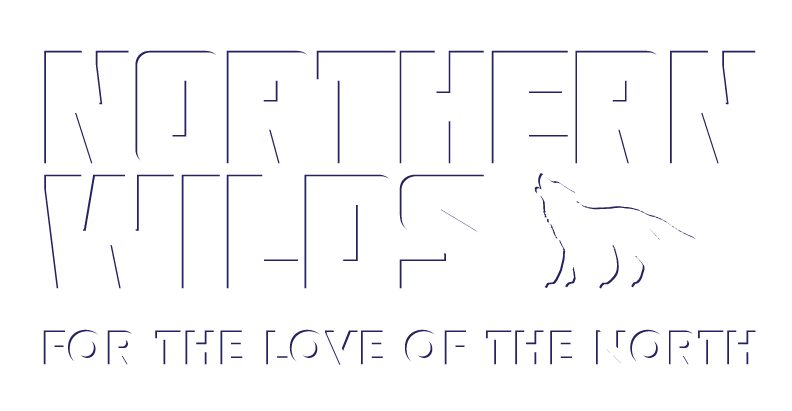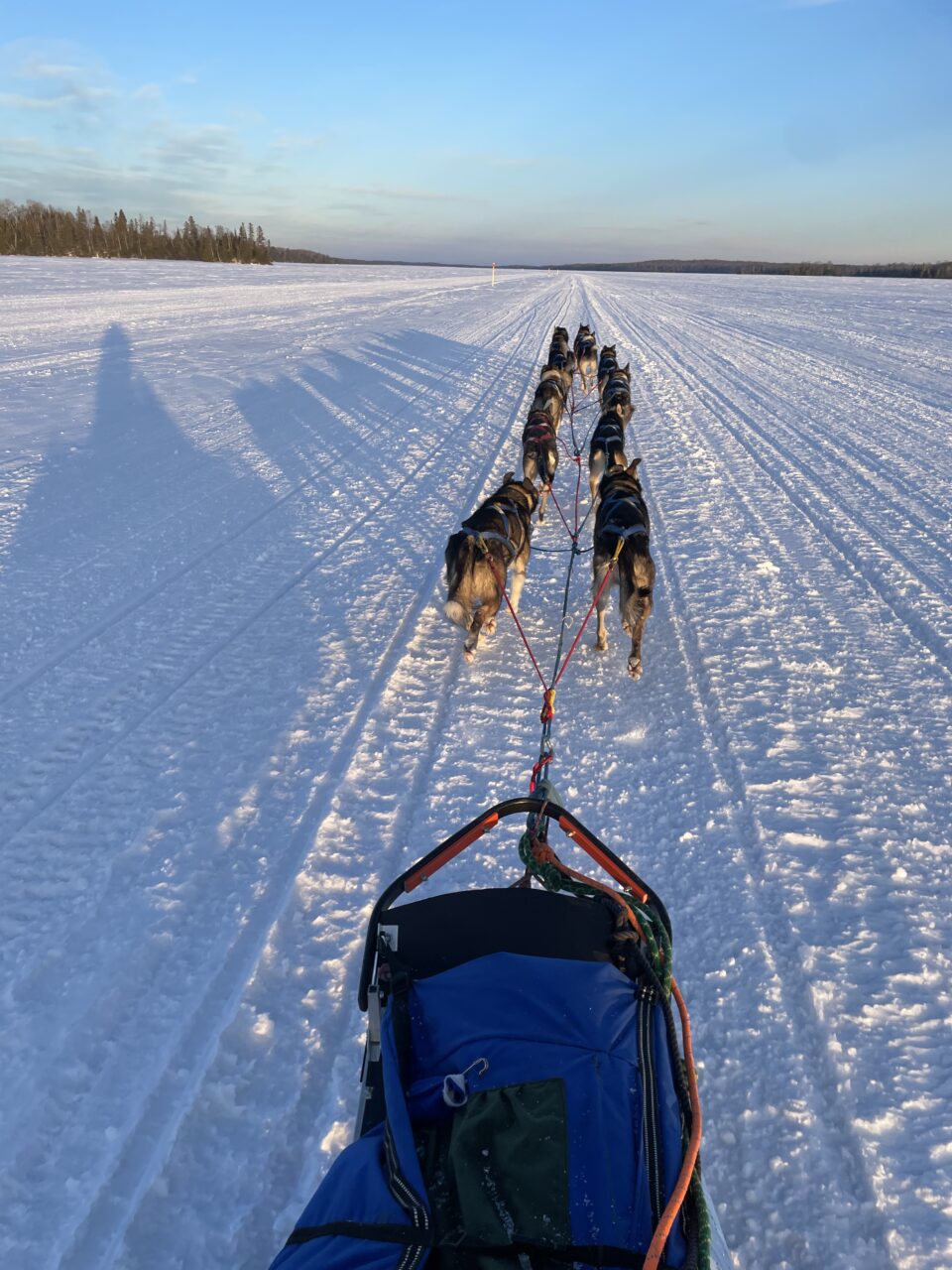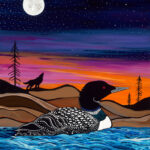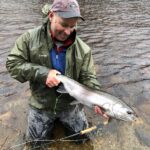UP200
I had my start time wrong and downtown Marquette was already chaotic. There were more people crowding a several block stretch than live in Cook County, and amidst that we had to ready the 12 dogs, sled, and musher for the 67-mile leg ahead. I spent too much time talking to people and suddenly it was time to start hooking up dogs, though I should have been doing this minutes ago, and because I had so many male dogs on the team, they were all growling at each other, and I couldn’t seem to find pairs that would run together. We were frantically switching dogs around trying to avoid a huge fight. The race people waved me ahead and I released the sled. There weren’t enough people holding the team and I did everything I could to hold them back. We were one team back from the start line and everyone let go except for one brave volunteer. The team dragged us both up to the start line where the “hooker” as they are called, took my snow hook and hooked down to a chain that held the team for a brief minute before we shot down the main street of Marquette and into the night.
For the first few miles, as we wound our way out of Marquette, the trail followed the highway. It was a paved trail with a too-thin cover of snow and my brake dug into the pavement as I attempted to slow my team down to a reasonable pace. We passed Remy Leduc after just a few miles and I yelled “This is crazy!” as we passed, but he didn’t hear me. For 67 miles I tried to hold my team at a reasonable pace. I was bib 14 and we passed all but three or four teams in front of us.
The next leg would bring us to the halfway point of Grand Marais, Mich. The trail was really punchy now. Recent snows did not pack well, and the trail felt somewhat bottomless. We maintained a decent speed and I left with the full team of 12 dogs, but there were a couple with questionable issues—stiffness that might turn into some kind of injury, and sure enough, Monster started limping halfway through the run. Soon, I was offering him a ride. Monster spent the next 25 miles looking at me from the sled and giving me occasional kisses.
At the checkpoint however, it was clear the trail had taken a toll on several dogs. I left after a five-hour rest with only eight dogs. Erin Aili and I had very similar run times and I left several minutes behind her. At one point, I saw her up ahead, but then I had to stop and switch out my leaders and Erin disappeared.
Leaving Wetmore for the finish, I was in second position. I had an eight-minute lead on Erin. I left with my most trusted leaders Temper and Keith up front, but within a mile Temper decided he didn’t want to lead, despite his experience in this race. I stopped to switch him out with 3-year-old Data.
Data almost didn’t come to the UP. After a long training run and the Gunflint Mail Run, he was a bit skinny. But after loading all the other dogs for the race, I was walking around the dog yard and I thought Data looked pretty good, so I threw him on the truck. He had grown into a phenomenal leader this year and saved me on the third leg when Temper didn’t want to lead. Data slipped from my fingers though and ran off into the dark. I called after him, thinking he’d come right back. He did not. We followed him down the trail.
Soon we crossed a road and the race marshal and several volunteers there say they saw Data come through and keep going. He was following the trail at least. There was a major highway coming up and I asked to have the volunteers watch for Data.
We mushed on. Still no Data. At the highway, Josh and Woody were there and ready. They said they hadn’t seen Data. But then Josh looked behind me and up ran Data. Josh grabbed him, I hooked him up in lead and we ran towards the finish.
Over the next 50-some miles, we went from maintaining a respectable pace to finally slowing down to a crawl. It began snowing quite heavily and even though there was a team ahead of us somewhere, we were breaking trail through 5-6 inches of snow and the leaders, first Keith and then Data, couldn’t keep the pace. Erin Aili eventually caught and then passed us. I cycled through almost every dog in the team trying to find leaders that would do the job and Temper and Itsy decided they would until we hit “the grade” which was the main snowmobile trail in and out of Marquette. We were almost at the finish—maybe 5 or 6 miles left—but the constant snowmobile traffic was too much for these leaders now and they quit. Data went back up front. He ran single for a few miles. Finally, with Taco as his partner, Data took us to the finish in third place, our best finish in the UP200 to date.

Beargrease Marathon
The week leading up to the Beargrease there were daily emails from our musher rep. The weather was warm and the trail out of Duluth deteriorated by the day. The start was pushed back to Two Harbors. Then, the board decided we should start with fewer dogs and add more in at the second checkpoint because even the trail out of Two Harbors was bad. At one point on Tuesday, our musher rep said, “You still have time to drive to Can-Am if you want.” At least one musher in the mid-distance dropped out and went to the Copper Dog instead.
We had the option of starting with eight or fewer dogs and I started with seven. The first leg went fine with seven dogs. I could control my small team, and we traveled plenty fast over the icy trail. The Finland checkpoint was all gravel, and it was so warm we had to lay down straw in puddles of water for the dogs. After two hours of rest, I added in the fresh five dogs and we took off, me fearing for my life behind a now very powerful team of 12 on a not great trail. For the next 30 miles to Sawbill I stood on the brake, trying to slow down this powerful team. Unlike the trail in the UP, which was snowy and bottomless, now we were on hard, icy trail and moving fast. At one point halfway to Sawbill, I rounded a turn at the top of a hill and hit a huge patch of ice on a downhill. The sled skidded outward very fast and flipped. I landed hard on my elbow. Wincing, I withdrew my elbow inward, holding the handlebar tight as we careened down the hill. Finally, the dogs stopped, I got a hook in, and I up-righted myself. Later we hit another sharp turn, and I took out a sign. On the next leg, we turned onto a plowed road. Unable to slow down, the dogs didn’t take my haw command and continued down the road until I could finally get my hook into the snowbank on the side. This was a situation I had really tried to avoid, and one I feared. I had most of my Iditarod team here, including two females that liked to start a fight at any opportunity—this was one of those opportunities. And would my hook hold once I turned the team? If it didn’t, I needed to: A) catch the sled as it went by, and B) not allow the team to bunch into a tangle, which would allow said females to get into said fight. I grabbed the leaders and whipped them around on a 180-degree course on the road. Snarling ensued. I continued leading them around as fast as I could. This went pretty smooth. Now we needed to make a sharp gee on a trail that was meant to be accessed from the other direction. By the time the sled hit, we were going up and over a 7-foot berm. The sled got stuck on top. I pushed and pushed. Nothing. I put in the sled hook off to the left, flipped the sled off to the side, and freed the sled, but now my snowhook was set so hard I couldn’t free it. I thought I had learned how to solve this problem last year when I kept setting my hook too hard with the 16-dog team in the Iditarod. Nic Petit stopped at one point to help me and showed me how to pull my sled back to free my hook. I tried that now, but to no avail. After several minutes of struggle, I finally freed the hook and off we went.
The next couple of legs were uneventful. We had a solid run towards Skyport, picking up a few minutes on the race leader Erin Aili. The race was between us, the two Erins. I enjoyed running Devil Track Lake at sunset and a crowd welcomed me at Skyport Lodge, snapping pictures of the sunset behind me as I came in.
On the way to Mineral Center, at 2 a.m., I crossed the Arrowhead Trail and a volunteer reached out to hand me a bag of cookies. I leaned to grab the cookies and tipped my sled, slamming my knees in the ground and dragging 50 feet across a gravel parking lot. As I stopped, Beth, the volunteer, handed me the cookies, which I took. I uprighted the sled and continued. The trail wove on and off a plowed road here, and at one point we bunched up and a small fight ensued. Then two things appeared: on the left was a corn dog stand on the plowed road, and on the right up ahead, signs and a large hole in the trail. Mind you, it’s 3 a.m., and I was still recovering from being dragged on the gravel and I couldn’t understand where I was supposed to go. The team ran over an arrow sign pointing to the left before I called them left up onto the plowed road. We passed by the corn dog stand, where every year some friends of ours hand out corn dogs and beers to passing mushers. While most years I welcome the food, this year I just felt fed up.
“I don’t want any corn dogs!” I yelled to Josh, who was trying to hand off some corn dogs and beer. I kept going and he was trying to tell me something, but I couldn’t hear him.
Despite my mishaps, I made up more time on Erin Aili, but leaving Mineral Center we were still 10 minutes behind her. We didn’t have a stellar run to the finish, so second place we earned, a fine finish for Sawtooth Racing. Best of all, some young dogs stepped up to lead the race.
Now as I finish writing this, I keep my eye on the Iditarod standings, watching my friend Emily Ford make her way towards Nome. I feel a mix of emotions, envy and trepidation, wondering if I will have the stamina and courage to try the big race again. This year was a wild success for us, and it would be the easy thing to keep doing these races in the lower 48. Stay tuned for future plans and fingers crossed for a great winter in 2025-2026.




